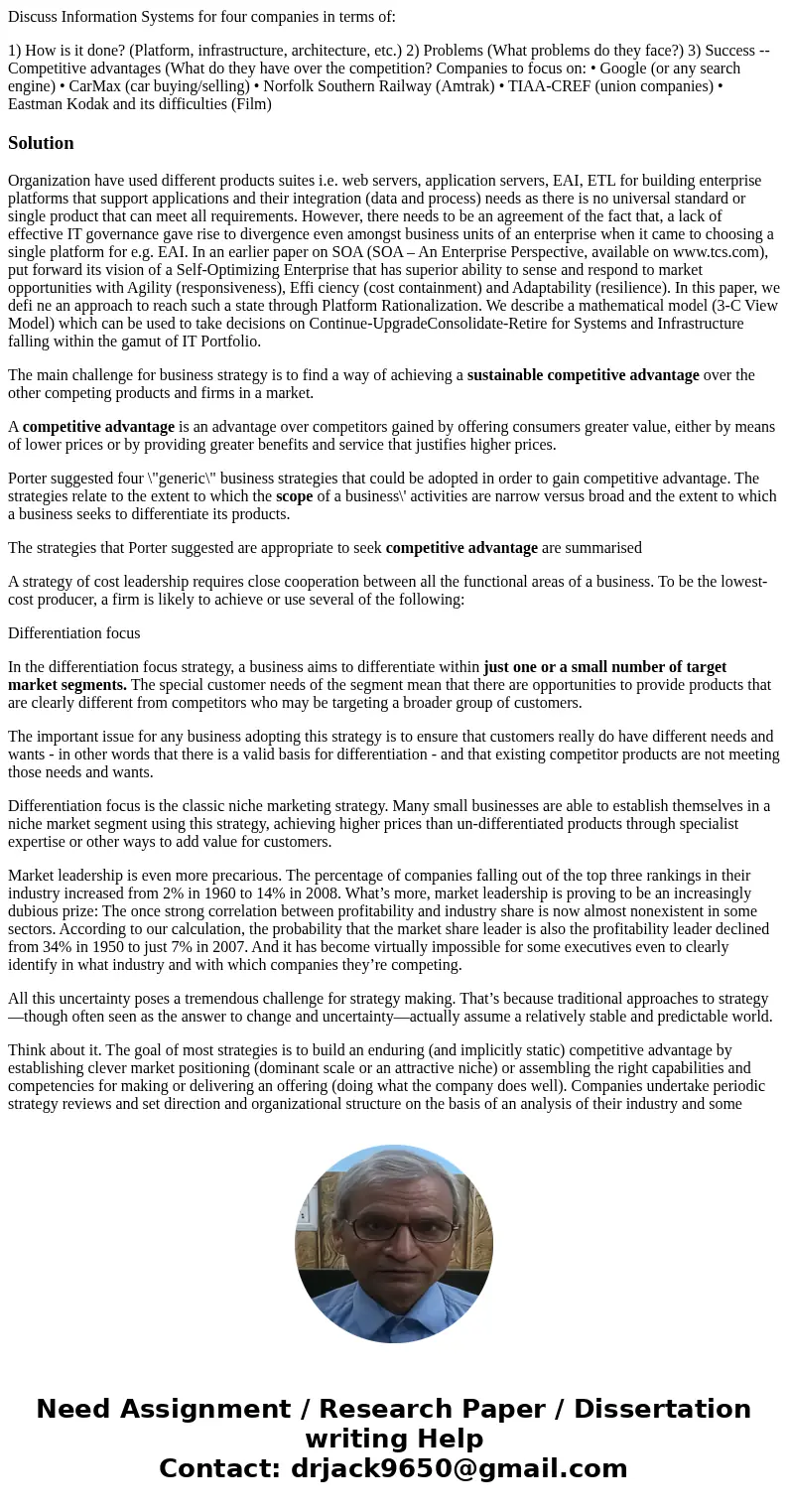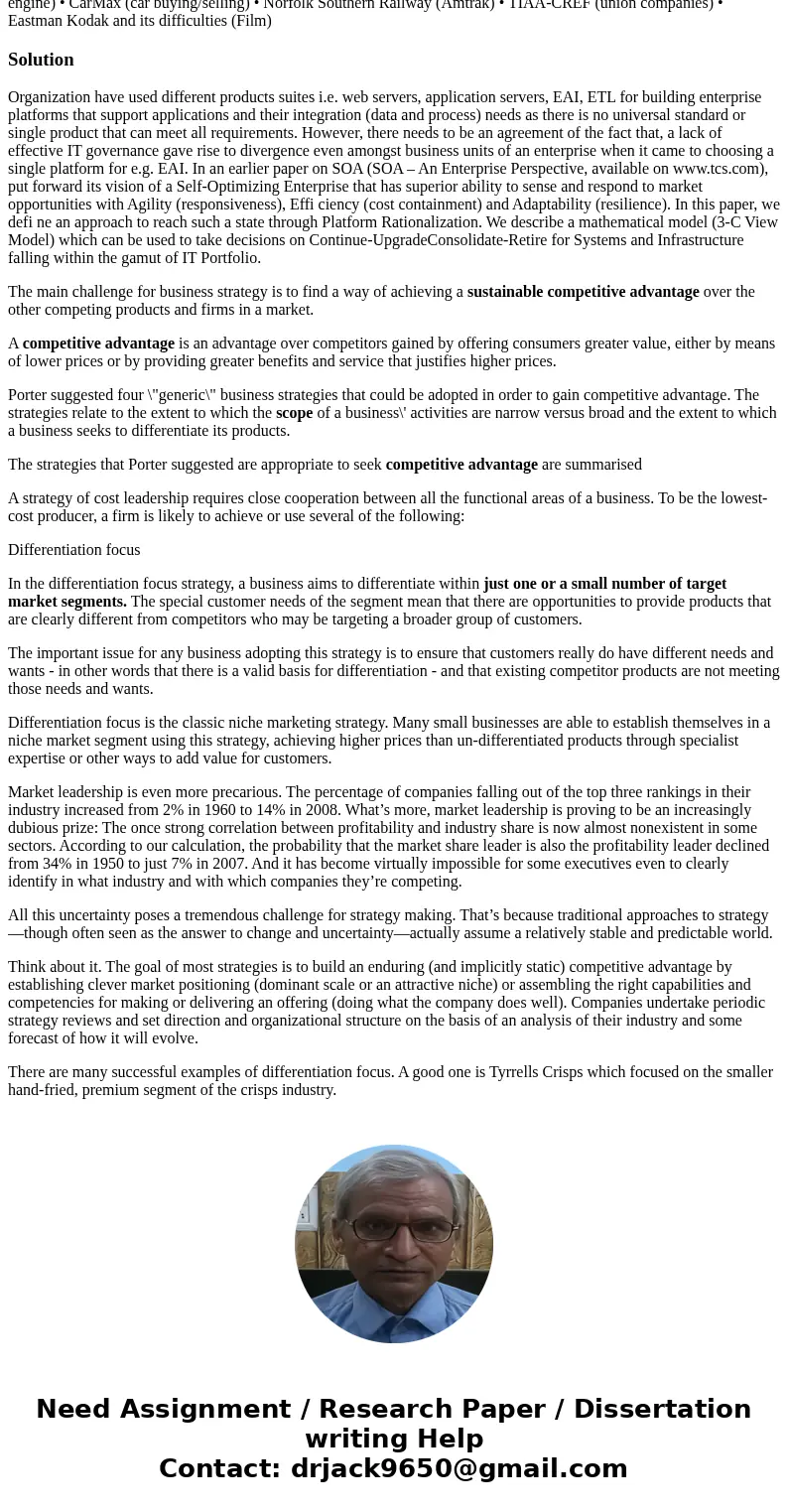Discuss Information Systems for four companies in terms of 1
Discuss Information Systems for four companies in terms of:
1) How is it done? (Platform, infrastructure, architecture, etc.) 2) Problems (What problems do they face?) 3) Success -- Competitive advantages (What do they have over the competition? Companies to focus on: • Google (or any search engine) • CarMax (car buying/selling) • Norfolk Southern Railway (Amtrak) • TIAA-CREF (union companies) • Eastman Kodak and its difficulties (Film)
Solution
Organization have used different products suites i.e. web servers, application servers, EAI, ETL for building enterprise platforms that support applications and their integration (data and process) needs as there is no universal standard or single product that can meet all requirements. However, there needs to be an agreement of the fact that, a lack of effective IT governance gave rise to divergence even amongst business units of an enterprise when it came to choosing a single platform for e.g. EAI. In an earlier paper on SOA (SOA – An Enterprise Perspective, available on www.tcs.com), put forward its vision of a Self-Optimizing Enterprise that has superior ability to sense and respond to market opportunities with Agility (responsiveness), Effi ciency (cost containment) and Adaptability (resilience). In this paper, we defi ne an approach to reach such a state through Platform Rationalization. We describe a mathematical model (3-C View Model) which can be used to take decisions on Continue-UpgradeConsolidate-Retire for Systems and Infrastructure falling within the gamut of IT Portfolio.
The main challenge for business strategy is to find a way of achieving a sustainable competitive advantage over the other competing products and firms in a market.
A competitive advantage is an advantage over competitors gained by offering consumers greater value, either by means of lower prices or by providing greater benefits and service that justifies higher prices.
Porter suggested four \"generic\" business strategies that could be adopted in order to gain competitive advantage. The strategies relate to the extent to which the scope of a business\' activities are narrow versus broad and the extent to which a business seeks to differentiate its products.
The strategies that Porter suggested are appropriate to seek competitive advantage are summarised
A strategy of cost leadership requires close cooperation between all the functional areas of a business. To be the lowest-cost producer, a firm is likely to achieve or use several of the following:
Differentiation focus
In the differentiation focus strategy, a business aims to differentiate within just one or a small number of target market segments. The special customer needs of the segment mean that there are opportunities to provide products that are clearly different from competitors who may be targeting a broader group of customers.
The important issue for any business adopting this strategy is to ensure that customers really do have different needs and wants - in other words that there is a valid basis for differentiation - and that existing competitor products are not meeting those needs and wants.
Differentiation focus is the classic niche marketing strategy. Many small businesses are able to establish themselves in a niche market segment using this strategy, achieving higher prices than un-differentiated products through specialist expertise or other ways to add value for customers.
Market leadership is even more precarious. The percentage of companies falling out of the top three rankings in their industry increased from 2% in 1960 to 14% in 2008. What’s more, market leadership is proving to be an increasingly dubious prize: The once strong correlation between profitability and industry share is now almost nonexistent in some sectors. According to our calculation, the probability that the market share leader is also the profitability leader declined from 34% in 1950 to just 7% in 2007. And it has become virtually impossible for some executives even to clearly identify in what industry and with which companies they’re competing.
All this uncertainty poses a tremendous challenge for strategy making. That’s because traditional approaches to strategy—though often seen as the answer to change and uncertainty—actually assume a relatively stable and predictable world.
Think about it. The goal of most strategies is to build an enduring (and implicitly static) competitive advantage by establishing clever market positioning (dominant scale or an attractive niche) or assembling the right capabilities and competencies for making or delivering an offering (doing what the company does well). Companies undertake periodic strategy reviews and set direction and organizational structure on the basis of an analysis of their industry and some forecast of how it will evolve.
There are many successful examples of differentiation focus. A good one is Tyrrells Crisps which focused on the smaller hand-fried, premium segment of the crisps industry.


 Homework Sourse
Homework Sourse